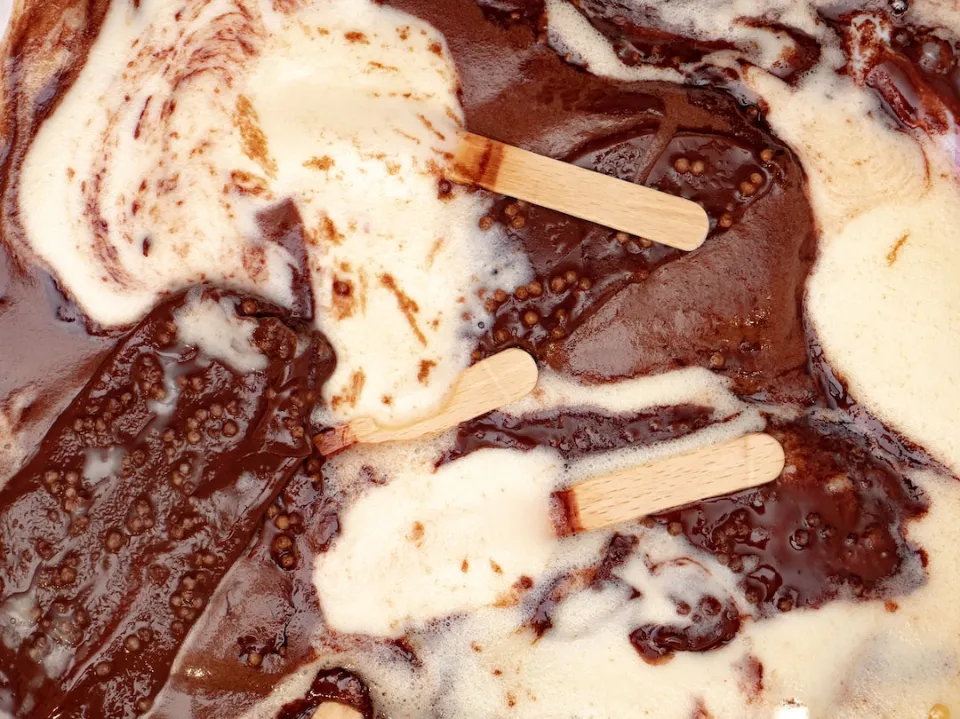You may want to refreeze ice cream that you can’t eat up. But can you do that? Here is what you need to know before refreezing melted ice cream.
It can be so simple to forget about the tub of ice cream you took out for the backyard barbecue and later discover it to be a melted mess. You might try putting the entire tub back in the freezer because it seems like such a waste to throw it away.
Can you refreeze melted ice cream? Despite the fact that you can technically refreeze melted ice cream, you shouldn’t. Firstly, there is the matter of food safety, and secondly, the melting and refreezing process will have unfavorable and unavoidable effects on the ice cream’s texture.
Read on to learn the main reasons why you shouldn’t refreeze melted ice cream.
Can You Refreeze Ice Cream?
Refreezing homemade ice cream is not recommended. You should try to eat homemade ice cream as soon as it is prepared.
There is a very high chance of bacteria forming inside homemade ice cream because it lacks preservatives. Homemade ice cream is unfit for consumption as soon as it is prepared because it is vulnerable to contamination.
Store-bought ice cream that has melted is safe to refreeze, but doing so alters the flavor and texture. Once the ice cream has completely melted, there is a significantly greater chance that bacteria will get into it.
Ice cream that has melted or softened to a certain extent can be safely refrozen. You can refreeze your ice cream without experiencing a significant change in flavor or texture if it has barely thawed or melted.
Long-term storage of refrozen softened ice cream is possible. Eating melted or improperly refrozen ice cream poses significant health risks and can result in food poisoning. The quality, taste, and texture of the product may also be affected.

Reasons Why You Should Not Refreeze Melted Ice Cream
Ice cream that has already melted completely is not worth trying to refreeze. The risks are too great, and the ice cream’s flavor and quality will suffer greatly as a result.
Here are the three main reasons why you should never refreeze melted ice cream:
It is Unsafe
Despite occasionally containing eggs, ice cream is a dairy product. If left at room temperature or in a warm environment for an extended period, there is a good chance that harmful bacteria will begin to grow.
This process can take some time because ice cream is initially frozen, but it will undoubtedly occur if the ice cream is exposed to the sun or is kept at room temperature for an excessive amount of time. One of the main concerns is listeria, which can lead to serious food poisoning.
The Texture Changes
Ice crystals that are uniform and incredibly small form when ice cream is frozen for the first time. Once the ice cream is refrozen after melting, larger ice crystals form, and this leads to a very grainy texture which is pretty unpleasant to eat. Instead of being a rich, creamy ice cream, the ice cream will be more akin to very finely crushed ice.
Loss of Air
When ice cream is made, the air is whipped into it during the churning process. This gives the ice cream a creamy, light texture.
As the ice cream melts, the air which has been whipped into it is lost, so refreezing the ice cream turns it into a dense block, and it will need to be re-churned to get the air back.

Best Way to Refreeze Ice Cream
You can follow the steps mentioned below to ensure the safe refreezing of ice cream:
- The freezer’s temperature should be checked first. To safely refreeze ice cream, it must be stored at 0°F or even lower.
- Put the melted ice cream in a flat, freezer-safe container after adjusting the temperature. Be careful not to overfill the container and leave a half-inch gap at the top for expansion after refreezing.
- To prevent ice crystals from forming on the ice cream’s top layer, place a plastic sheet over the surface. Additionally, doing so will lessen the possibility of freezer burns.
- In order to preserve the majority of the ice cream’s quality and texture, seal the container properly after that.
- The ice cream container can also be labeled to help you remember the refreeze date.
- To ensure that the ice cream is properly refrozen, place the tightly sealed container in the coldest area of the freezer.
Avoid putting the container of ice cream in the freezer door when refreezing it. Ensure that the container is partially frozen before placing it. See How Long Ice Cream Lasts in the Freezer.
How Long Is It Safe to Refreeze Ice Cream?
Ice cream that has been stored properly can be kept refrozen indefinitely without risk. Up to a year can pass while refrozen store-bought ice cream remains unopened in the freezer. Just make sure it is kept at or below 0°F while being stored. Preservatives significantly extend the shelf life of ice cream purchased from a store.
Although eating homemade ice cream within a week of refreezing is safe, it is not yet advised. It may lose some of its original texture, quality, and flavor, but it will still be safe to eat.
The ice cream shouldn’t be left at room temperature for longer than two hours. Let’s say you unintentionally forgot to take the ice cream off the counter. In that case, it is suggested that you throw it away right away.

Can You Fix the Texture of Refrozen Ice Cream?
Ice cream’s texture will change irreversibly after it has melted and refrozen. All of the air that was added during the churning process is lost as the ice cream melts.
Those flawlessly tiny ice crystals stick together and cluster into large groups when they refreeze. A disappointingly dense block that was challenging to scoop and was covered in crunchy icy pieces was the outcome!
Can You Eat Melted Then Refrozen Ice Cream?
You can eat melted and refrozen ice cream, but you really shouldn’t. It is best to just stay away from it altogether because the risk of contracting listeria or food poisoning is not worth it.
In addition to the possibility of contracting food poisoning, the ice cream’s texture, flavor, and quality simply aren’t worth the danger. It will also be disappointing. Instead, simply remove a scoop of ice cream that is completely frozen and put it back in the freezer.
This way you do not risk the ice cream melting, and then having to risk refreezing it, and it ensures your ice cream will have the best quality when you go back for seconds!
Final Words: Don’t Refreeze Ice Cream
After the ice cream has melted, it is not advised to refreeze it. The potential for food poisoning is very high because of the ideal ice cream environmental conditions for bacterial growth. In addition, eating refrozen ice cream would not satisfy your desire for the luscious, creamy texture you so desperately desire.
Ice cream can only be safely refrozen if it has been kept cold and has only slightly melted. It might not be safe to eat if it was refrozen after melting outside the freezer.
FAQs
How Long Does Unopened Ice Cream Last in the Freezer?
Ice cream has a shelf life of up to 12 months if kept in its original packaging without being opened. A temperature of 0 degrees Fahrenheit must be maintained at all times.
Can I Eat Ice Cream Past the Expiration Date?
If there are no signs of spoilage, it is usually acceptable to consume ice cream after its expiration date. The ice cream container should be marked with a best by, best before, or best used by date; however, these do not typically denote a safety date.
Can You Refreeze Ice Cream More Than Once?
You can successfully refreeze partially melted ice cream multiple times if you carefully follow the refreezing instructions. You can put the ice cream back in the freezer as often as you’d like as long as it has only slightly thawed.


